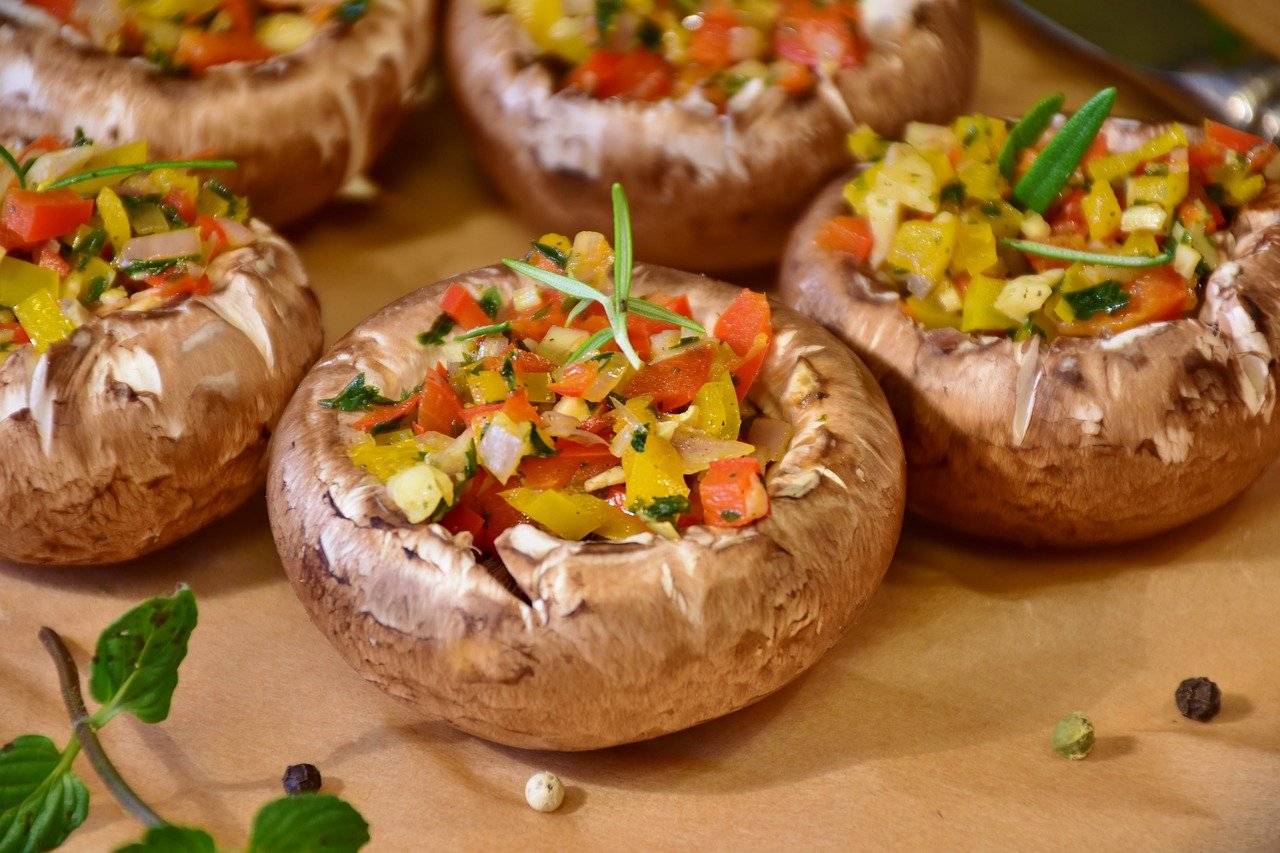
Exploring the negative effects of portobello mushrooms is crucial in the context of healthy eating, despite the considerable hype surrounding this popular food.
The portobello mushroom, celebrated for its meaty texture and culinary versatility, has carved out a significant niche within vegetarian and vegan dietary plans.
Nonetheless, despite their numerous advantages, it’s vital to scrutinize the potential downsides associated with consuming portobello mushrooms.
In this blog post, we’ll explore some of the potential downsides of incorporating these mushrooms into your diet and whether or not they are really worth it.
Unveiling the Popular Portobello Mushrooms
Portobello mushrooms, with their distinctive meaty texture and earthy flavor, have become a popular choice among both vegetarians and meat lovers alike.
These mushrooms, which are actually fully mature cremini mushrooms, have gained fame for their versatility and ability to mimic the texture of meat in dishes.
Meat Substitute
One of the main reasons behind the popularity of portobello mushrooms is their ability to be used as a meat substitute. Their large size and hearty texture make them an excellent choice for replacing meat in dishes such as burgers, sandwiches, and even as a steak alternative.
Mild Flavor
Their mild flavor also allows them to easily absorb the flavors of other ingredients, making them a versatile ingredient in various cuisines.
Versatile
Not only are portobello mushrooms versatile in the kitchen, but they also offer several nutritional benefits not to mention low in calories.
Nutritious
They are also a good source of dietary fiber, potassium, and vitamins B and D. Additionally, portobello mushrooms contain a compound called ergothioneine, which is believed to have antioxidant and possessing anti-inflammatory properties, they can support overall health and well-being.
Easy to Find
Aside from their nutritional value, portobello mushrooms are also relatively easy to find and affordable compared to some other specialty mushrooms. They can be found in most grocery stores and farmers’ markets, and their price is typically reasonable, making them accessible to a wide range of consumers.
Vegetarian Diets
In recent years, the rise of vegetarian and vegan diets has further contributed to the popularity of portobello mushrooms.
These diets often rely on plant-based ingredients that provide the necessary nutrients to replace meat and other animal products.
Portobello mushrooms, with their meaty texture and umami flavor, are an ideal ingredient for those following these dietary choices.
Despite their popularity, it’s important to note that portobello mushrooms may not be suitable for everyone. Some people may have an allergic reaction to mushrooms, so be take caution.
Additionally, some individuals may experience digestive issues, such as bloating or gas, after consuming mushrooms. I
f you have any concerns or pre-existing medical conditions, it’s best to consult with a healthcare professional before incorporating portobello mushrooms into your diet.
The Dark Side: Potential Negative Effects of Portobello Mushrooms

While portobello mushrooms have gained popularity for their versatility and nutritional benefits, it’s important to take a closer look at the potential health risks associated with consuming these mushrooms.
Although they are generally safe for most people, there are a few considerations to keep in mind.
Possibility of Bacterial Contamination
First and foremost, it’s crucial to ensure that the portobello mushrooms you consume are cooked thoroughly. Raw or undercooked mushrooms can contain harmful bacteria.
By cooking them properly, you can significantly reduce the risk of any bacterial contamination.
Presence of Allergen Compounds
Another potential health risk is the presence of allergenic compounds in mushrooms, including portobellos. Some individuals may have a specific allergy to mushrooms, which can cause mild to severe allergic reactions.
If you have a known mushroom allergy or have experienced any adverse reactions in the past, it’s important to avoid consuming portobello mushrooms or any other types of mushrooms.
Different Nutrient Composition
Furthermore, it’s important to note that portobello mushrooms belong to the fungi kingdom, which means they have a different nutrient composition compared to plants.
While they do offer several nutritional benefits, such as being low in calories and fat, high in fiber, and a good source of vitamins and minerals, they are not a complete source of all essential nutrients.
For a well-rounded and balanced diet, it’s important to incorporate a variety of other plant-based foods to meet all your nutritional needs.
Have Naturally Ocurring Purines
It’s also worth mentioning that mushrooms, including portobellos, have naturally occurring purines. Purines are substances that can be broken down into uric acid in the body.
Excessive intake of purine-rich foods may lead to an accumulation of uric acid, which can contribute to the development of gout in susceptible individuals.
If you have a history of gout or other conditions related to high levels of uric acid, it may be wise to moderate your intake of portobello mushrooms.
Potential for Contamination
Lastly, it’s important to consider the potential for contamination of portobello mushrooms with heavy metals or pesticides.
Like many other fruits and vegetables, mushrooms can absorb and accumulate heavy metals or pesticide residues from the environment in which they are grown.
To minimize your exposure to these substances, it’s advisable to opt for organic or locally sourced mushrooms whenever possible.
Unfavorable Environmental Negative Effects of Portobello Mushrooms Cultivation
As we delve into the potential downsides of incorporating portobello mushrooms into our diets, it’s important to consider the environmental impact of their cultivation.
While these mushrooms have gained popularity for their taste and nutritional benefits, their production does come with some unfavorable consequences for the environment.
Resources
Firstly, the cultivation of portobello mushrooms requires a significant amount of resources. Growing these mushrooms often involves large-scale operations that require vast amounts of water, energy, and land.
The water consumption alone is quite substantial, as mushrooms require high humidity levels to grow successfully.
This demand for water can put strain on local water sources, especially in regions already experiencing water scarcity.
Energy
Additionally, the energy requirements for cultivating portobello mushrooms can contribute to carbon emissions and environmental degradation.
The production of these mushrooms often involves the use of controlled environments, such as indoor facilities or mushroom houses, which require heating, cooling, and ventilation systems.
These systems consume electricity and contribute to greenhouse gas emissions, adding to the overall carbon footprint of mushroom cultivation.
Fertilizers and Pesticides

Furthermore, the use of pesticides and fertilizers in mushroom farming can have adverse effects on the environment.
Like other crops, mushrooms are susceptible to pests and diseases, which can impact their yield and quality.
To combat these issues, farmers often rely on the use of chemicals, such as pesticides and fungicides, to protect their crops.
However, the excessive use of these chemicals can lead to soil and water contamination, harming the surrounding ecosystems and wildlife.
Mushroom Waste Disposal
Another aspect to consider is the disposal of mushroom waste. During the cultivation process, mushrooms generate a significant amount of waste material, including the compost substrate used for growing them.
This waste needs to be managed properly to prevent pollution and minimize environmental impact.
Improper disposal methods can lead to the release of harmful gases, such as methane, a potent greenhouse gas, into the atmosphere.
Need for Sustainable and Environmentally Friendly Food Production

While efforts are being made to reduce the environmental impact of mushroom cultivation, there is still room for improvement.
Some farms are implementing more sustainable practices, such as using renewable energy sources, optimizing water usage, and adopting organic farming methods.
As consumers, we can also play a part in minimizing the environmental impact of portobello mushroom cultivation.
Choosing locally sourced and organic mushrooms can help support sustainable farming practices and reduce the carbon footprint associated with long-distance transportation.
Additionally, reducing food waste by properly storing and consuming mushrooms before they spoil can also make a positive impact.
Final Thoughts: Balancing Benefits and Negative Effects of Portobello Mushrooms
As we come to the end of our exploration into the negative effects of portobello mushrooms, it’s important to reflect on the overall balance of benefits and risks associated with incorporating these fungi into our diets.
On one hand, portobello mushrooms offer a variety of advantages that make them an appealing addition to many meals.
Their versatility in the kitchen allows for creative culinary exploration, and their ability to mimic the texture of meat makes them an ideal choice for those following vegetarian or vegan diets.
Additionally, their low calorie and fat content, combined with their nutritional value, make them a healthy option for those looking to maintain or improve their overall well-being.
However, it’s crucial to consider the potential risks and downsides as well.
It’s essential to be aware of any known allergies and avoid consumption if necessary. Furthermore, individuals with pre-existing medical conditions, such as gout or high levels of uric acid, should moderate their intake of portobello mushrooms due to their purine content.
The environmental impact of portobello mushroom cultivation is another factor to take into account.
The resource-intensive nature of growing these mushrooms, including water consumption, energy requirements, and the use of pesticides and fertilizers, can contribute to environmental degradation.
However, efforts are being made to adopt more sustainable practices, and as consumers, we can support these initiatives by choosing locally sourced and organic mushrooms.
Ultimately, the decision to include portobello mushrooms in your diet comes down to personal preference and individual circumstances.
It’s essential to weigh the potential benefits against the risks and make an informed choice. If you have allergies or pre-existing medical conditions, it’s crucial to consult with a healthcare professional before incorporating portobello mushrooms into your meals.
Additionally, considering the environmental impact and supporting sustainable farming practices can contribute to a more conscientious approach to food consumption.

In conclusion, while portobello mushrooms have gained popularity for their taste, texture, and nutritional benefits, it’s important to approach their consumption with a balanced perspective.
By being mindful of potential allergenic reactions, health considerations, and environmental impact, we can make informed choices that align with our individual needs and values.
Whether you decide to enjoy portobello mushrooms as a delicious and versatile ingredient or opt for other alternatives, the key is to prioritize your well-being and the well-being of the planet.
Related Articles:
How to Perfectly Blanch Green Beans in Five Simple Steps
Healthy Habits Start with Clean Fruit: How to Clean Fruit Like a Pro





